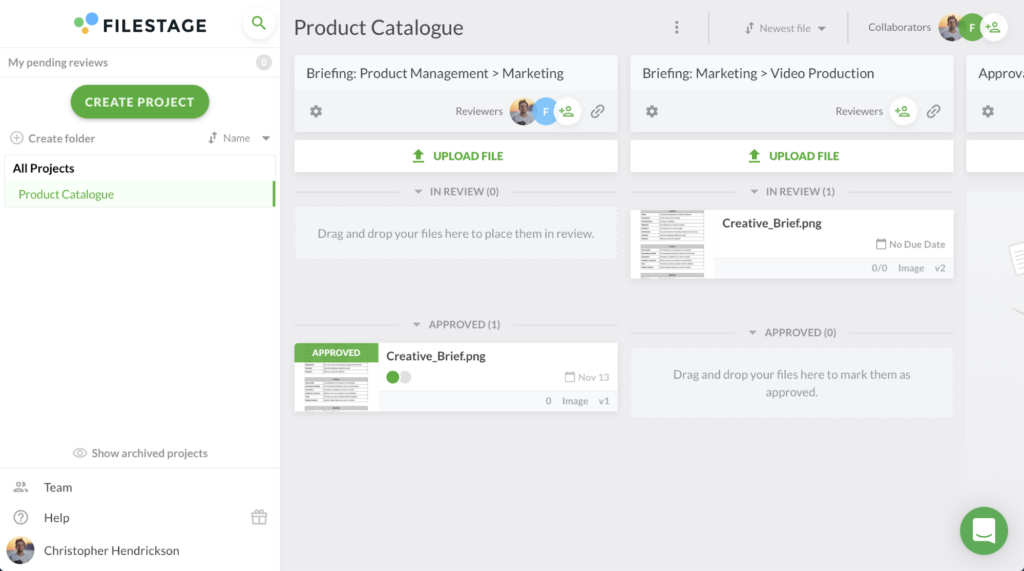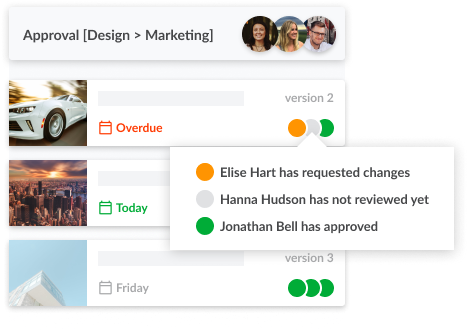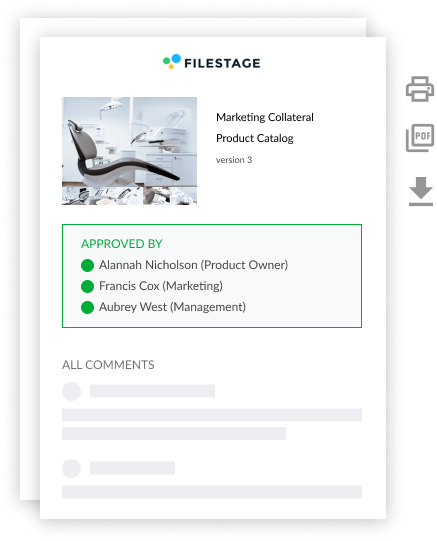Product catalogs are a great way for businesses to provide their prospective buyers with a detailed list of their inventory. These attractive print and digital documents contain lots of lush images, vivid descriptions and exhaustive details.
These documents are undoubtedly valuable, but they’re not very easy to produce. You’ll need to collect information from many different stakeholders, and make sure that your catalog is flawless, before it goes to print.
Are you ready to conquer the product catalog design process?
In this post, we’re going to outline a winning strategy that you can use to make the process of designing your product catalog a breeze.
Why Is it so Challenging to Manage a Product Catalog Design Process with Many Stakeholders?
Before we dive into the process you can use for your product catalog design, let’s take a quick look at exactly why it’s so important to have a clearly defined process.
Here are seven reasons why it can be challenging to manage the design process.
1. You might lack a single file
Product catalogs are complex documents, meaning you’ll need to collect information from a number of stakeholders within your business. Product details may change and design feedback has to be implemented on a regular basis.
Not having a centralized file can quickly lead to countless conflicts and errors. You’ll risk having lots of different working files at the same time and this can cause a great deal of confusion.
2. Long rounds of feedback between numerous people
You’ll need to collect feedback and input from countless people while you’re creating your product catalog. Senior members of the team will need to review it, for example, and your copywriters and product team members will have to confirm everything is correct.
Your document will circulate between different groups and this can cause significant delays and leave you waiting for valuable feedback.
3. Version control and feedback are difficult to monitor
Over the course of your project, your team will create a number of different versions of the catalog. This can pose a challenge as your team members work and review often conflicting file versions and leave imprecise feedback.
A clear design process can guide you to avoid this pitfall and move your project along as efficiently as possible.
4. Information silos cause roadblocks
Each member of your team performs a unique function and plays an important part in your project, but this means that there’s an element of risk involved. Whenever those people are out of the office, you’ll miss out on their input and expertise.
This situation can cause delays and mistakes, which is why it’s critical to have a clear design process that accounts for any problems areas or bottlenecks.
5. Chasing colleagues for feedback
Because you want to create a really excellent product catalog, you’ll need to activate your multi-disciplinary team members. They’ll each have their own tasks and responsibilities, however, which means they might not have the time to offer fast and comprehensive reviews.
This means that without a distinct product catalog design plan, you’ll spend a significant amount of time chasing your colleagues up and requesting their feedback.
6. Internationalization presents new challenges
If you have an international customer base, you’ll probably need to produce your product catalog or a brochure in different languages. This can be very complex, given that you’ll have to coordinate translations and make sure that the designs accommodate the different lengths of text.
You’ll need to develop a strong and concise design plan,if you want to create a range of product catalogs, all at once, and in different languages.
7. Travel leads to process breaks
Corporate travel is more popular than ever before and it means that your team members might be out of the office at different times. They might find it difficult to work on the road, so you could miss some critical feedback on or input to your design.
However, a robust design plan for your product catalog, will make it easier to manage this risk and to get the timely feedback that you need.
Who’s Typically Involved?
Now that we’ve covered the challenges that you’ll need to tackle, we’ll briefly cover the key people and teams who are typically involved in the product catalog design process:
1. Project manager
The project manager, from the company that’s creating the catalog, plays a critical role in moving the project along to completion. This professional will use their impeccable project and people management skills to cover every eventuality as they move the catalog through their workflow.
The project manager acts as a bridge between all of the various stakeholders and this unique perspective allows them to guide the project to completion.
2. Marketing team
The marketing team within the company uses its strategic knowledge to commission the catalog and to shape its strategy. This team is responsible for creating a series of goals, and for ensuring that the catalog adheres to the company’s brand guidelines, and that it is an effective piece of marketing.
3. In-house design team (or design agency)
The actual design team can be an internal or external one. They will work in close cooperation with the marketing team and project managers to create an effective catalog.
A design team works best when it’s provided with accurate and clear feedback. The project manager must work very hard to ensure that all feedback is as transparent as possible.
4. Product team
The product team will need to provide the actual details for the catalog and ensure that all of the information contained within it is accurate. They’ll also need to play a strong role in the review and approval process.
The best project managers are able to facilitate clear communication between all of the different project groups to elevate the overall quality of the final product as much as possible.
What is the Ideal Workflow?
Now that we’ve covered why a plan is important, and who is going to be involved, let’s dive deeper into the ideal process that you can use for your product catalog design .
1. Important Preparation
Before you begin the workflow in earnest, you can make your life much easier by taking the time to lay the foundations of your project.
At this stage of the game, you’ll define all of the necessary workflow steps. These include:
- Briefing: Product Management > Marketing
- Briefing: Marketing > Design
- Approval: Design > Marketing
- Approval: Marketing > Product
- Approval: Product > Management
Here’s a look at what those workflow steps would look like if you created them within our content review and approval tool Filestage:

Nice and clear, right? Clear groundwork will help you and your colleagues keep a clear overview throughout the catalog design process.
2. Briefing [Product Management > Marketing]
Now that you’ve got the appropriate preliminaries in place, your product management team can initiate the project, by sharing their needs with marketing.
The product team will need to provide detail in the following areas:
- Why the catalog is needed
- What they’re hoping to achieve with the catalog
- The goals for the project
- References for other catalogs
- Clear and precise product information
All of that information should be shared in a comprehensive and creative brief.
The creative brief should be communicated in a transparent manner, so that the product manager and marketing team can ask any questions that they might have.
3. Concept [Marketing]
Once the creative brief has been polished and accepted by the rest of the team, it’s time for the marketing team to get to work.
The members of the marketing team will be required to create a winning concept for the catalog, in response to the creative brief. Their ideas will have to to take all of the preferences and information from the product team into account.
The marketing team should work in conjunction with the project manager, to establish clear deadlines and to ensure the appropriate documents are used.
Once again, it’s important that the marketing team shares their completed concept with the rest of the team. This ensures transparency and encourages everybody to leave any remarks or questions that they might have.
By the end of this stage, the marketing team will have a clear and inspiring concept that they’ll be able to share with the talented design team, to get things moving.
4. Briefing [Marketing > Design]
In this step, it’s time for the marketing team to transform its initial concept into an actionable briefing that they will share with the design team.
This briefing should encapsulate all of the information that came from the product team initially, and should blend together practical guidelines in the following areas:
- Design guidelines
- Size specifications
- Desired file formats
- Project goals
Depending on the nature of the project and your existing resources, this step might mean working alongside an in-house team or an external agency.
Once the design team has received the briefing, they might request changes and/or ask for clarification. We want to reiterate that it’s best to carry out this step as smoothly and transparently as possible. With the appropriate design tools and guidance from the project manager, the process will move along nicely.
At the end of this step, the product team will confirm the final brief and the design team will get to work.
5. Approval [Design > Marketing]
Now that the design team has the polished final brief, they’ll be able to get to work on the actual design itself.
These talented design professionals work their magic, using the tools and techniques that were outlined in the creative brief, provided by the marketing department. If they have questions over the course of the project, they’ll be able to use the established communication protocol to get the answers that they need.
Once the design team has a first draft ready, they will need to present it to the marketing team, for review. The marketing professionals will assess whether the design has hit the key points of the brief and decide what changes need to be made.

Online proofing software such as Filestage can help you streamline the approval process and bundle feedback in one place. Filestage can be also easily used as a main catalog design software tool.
This feedback loop will continue, between the marketing and design team, until there’s a final draft ready that everybody is happy with. The number of loops required will vary from one project to the next, of course, but it’s critical that the structure is respected.
6. Approval [Marketing > Product]
Once the design team has handed over the first draft of the finished product catalog, it’s time for the marketing team to go back to the product team to collect their feedback.
The marketing team must ensure that the feedback they get from the product team is precise and accurate, in order to avoid any confusion. For this reason, it’s essential that they use the established tools and lines of communication so be sure they get the best results.
A review and approval tool like Filestage can help the marketing team to make sure that no feedback is lost on the way.
The product team will need to pay particular attention to factors such as:
- The accuracy of specific product details
- The quality and accuracy of any images
- The suitability of the overall collateral
As with the previous steps, the product team should leave clear feedback which will be implemented in turn by the design team. This feedback loop will need to continue for as long as necessary until the product team has confirmed they are happy with the catalog.
7. Approval [Product > Management]
Once the product team has its final catalog ready, it will need to present the collateral to the executive team. Again, it’s important that this is done according to the guidelines and processes that were outlined by the project manager.
The management team will then review the catalogue. They’ll provide high-level guidance to move the project forward and will ensure that it’s a great fit in terms of strategy. If they have any changes, now is the time to pass those along to the design team.
It’s critical that the right tools and processes are used so that there’s still a high level of transparency. This will expedite the time that it takes for the management team to make requests and the design team to respond to those changes.

Once the final version has been approved by the management team, the catalog will be ready for final printing and distribution – congratulations!
Streamline Your Product Catalog Design Process Today
We hope that this closer look at the process of product catalog design helps you to move your project along as efficiently as possible and that you get some incredible results by the end.
As we’ve stressed it’s essential that you use the best techniques and tools. This adds a level of predictability and transparency that’s essential to producing your best possible work.
If you want to master the review and approval process, be sure to start your free Filestage trial today.





